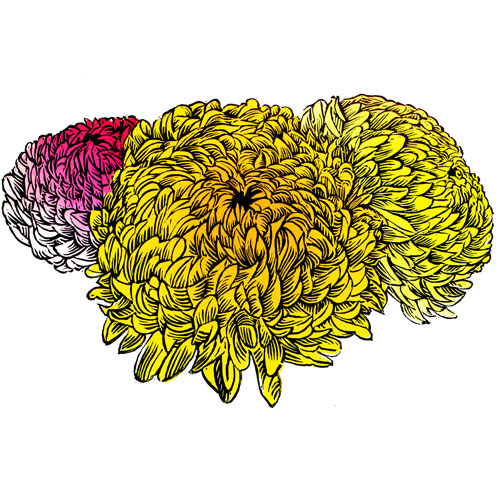
Hallo, I’m Masha Tiplady, Edinburgh-based printmaker, working primarily in linocut. I grew up in Moscow and moved to Scotland nearly 20 years ago to complete my Master’s degree and now call it home. I like creating colourful linocuts, using both reduction and multiple-plate techniques. I absolutely love carving, it’s such a meditative process and I often end up carving more tiny details than initially planned.

Describe your printmaking process.
My linocuts usually begin as a fairly vague image in my head – I hardly ever sketch at that stage and just let the image/colours develop in my imagination. Once the image in my head is clear enough I tend to draw straight on lino and start carving, often changing things as I go along. I don’t have a proper printing press and hand-burnish most of my linocuts with a wooden spoon and a glass barren. After I finish a new linocut, I usually put together a short video of the process and upload it on Instagram, Facebook and my website www.mashaandtheprints.com.

How and where did you learn to print?
I’m a self-taught printmaker. I discovered linocut by pure chance after attending a local workshop – I was suffering from a pretty bad postnatal anxiety at the time and just wanted to do something different to take my mind off things. I fell in love with linocut straight away and it quickly became my ‘happy place’/passion (and now – a full-time occupation). I started by reading a few books and watching many hours of YouTube videos and absorbing as much information as I could find on a subject. Then I just started carving and attempted my first reduction linocut (“A girl with a necklace”) only a few weeks later – it was a huge learning curve but I loved everything about it. I also joined an on-line linocut community – there is a large Facebook group called “Linocut Friends” which is a great source of practical advice and a friendly community of linocut-obsessed people. Last year I joined Edinburgh Printmakers and started learning intaglio techniques there – frankly, I’m fascinated by all printmaking techniques and will hopefully get a chance to try most of them.


Why printmaking?
To me, linocut is a perfect medium, which combines a thorough planning and methodical process with an element of a complete surprise. There is something so magical in watching the image to appear layer by layer and you are never sure what it’s gonna be like until you’ve finished the last layer. As many printmakers will agree – it’s such a thrill!
I also like the fact that linocut allows for pretty much endless possibilities of experimenting with colours.

Where do you work?
I’ve set up a small studio space at home and keep expanding (basically, taking over the living room inch by inch). One day I hope to have a separate studio but at the moment such set up works for us – it means I can juggle working with looking after our young daughter.
Describe a typical day in your studio.
At the moment, I have to plan my work around our daughter’s routine and available childcare – most days I will work in short bursts during the day and again for a good few hours in the evening.
What inspires you?
I find inspiration in things that interest me: my favourite books, music, history. Many of my linocuts have a retro feel to them: beginning of the 20th century and 50s-70s are my two favourite eras.

What is your favourite printmaking product?
I love my Pfeil gauges, I’ve built a nice collection that suits my mark-making needs. I’m also very fond of Flexcut tools – micro palm set in particular. As for ink, my favourite is Caligo Safe Washrange and traditional gold ink by Cranfield.
What have you made that you are most proud of?
It’s got to be my latest 10-colour reduction linocut “Murmuration’ – a commission which was great fun to make. It was my first go at a landscape and I’m very happy with the design I came up with and how it turned out.

Where can we see your work? Where do you sell?
You can see my work in Art & Craft Collective gallery in Edinburgh and Scottish Design Exchange in Buchanan galleries, Glasgow. You can also buy my linocuts from my website www.mashaandtheprints.com and on Etsy https://www.etsy.com/shop/mashaandtheprints/

What will we be seeing from you next?
I’m working on a new mid-century-themed reduction linocut and I have a couple of botanical designs on my mind (can’t get enough of flowers at the moment!). I’m also hoping to do more etchings this summer and try woodcut when I get a chance.
Do you have any advice for other printmakers and creatives?
Main advice would be just to go for it! In my experience, the best way to learn is to try something new, even if it scares you and feels overly-ambitious. You’ll make mistakes but that’s the best way to learn.
Links:
Website: www.mashaandtheprints.com
Etsy: https://www.etsy.com/shop/mashaandtheprints/
Facebook: https://www.facebook.com/mashatiplady/
Instagram: https://www.instagram.com/mashatiplady/















%20500.jpg)






%20500.jpg)

%20500.jpg)








